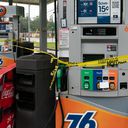Gas stations' long decline

The number of gas stations has been in steady decline for decades, and the volatility in gas prices — along with the rising popularity of electric vehicles — will squeeze them even further.
The big picture: President Biden is accusing gas stations of profiteering from high oil price, and at least four California cities have banned new stations. But most gas stations aren't owned by big multinational corporations, and the ups and downs of fuel prices is likely cutting into many of their bottom lines.
Gas prices, after spiking upwards, have now declined for 30 consecutive days, per Gasbuddy. That's good news for drivers, but terrible news for gas-station owners.
- The pattern of a sharp rise and then slow fall in gas prices is the worst possible dynamic for such businesses.
How it works: "Stations tend to hold back price increases to hold onto customers," said Jeff Lenard of NACS, the trade association for convenience stores.
- As the WSJ explains, when the gas station refills its own tanks, it buys weeks' worth of fuel — sometimes months' worth, in the case of diesel — at a single high price.
- If prices then start to fall, the gas station is forced to sell at below its own cost.
- The 2008 spike in gas prices was responsible for the demise of hundreds of gas stations, Lenard said.
Between the lines: This year might not be as bad for gas stations as 2008. Convenience stores sell more prepared food these days, which has higher margins and can help cushion any blow from gas-price volatility.
- Still, closures continue, including at least one in protest of high prices.
The gas station industry is surprisingly unconsolidated. 80% of the gas bought in America is purchased from a franchised convenience store that's individually owned — even if it bears the brand name of a multinational.
- In an industry where some operators set margins at a fixed rate of a few cents, higher gas prices translate to higher fees when customers pay with credit cards — which are set on a percentage basis and can eradicate those margins entirely.
The bottom line: Though mom & pop shops still dominate, big box stores have muscled into the game. Once they start using gas as a loss-leader, smaller players are forced to lower their prices or face going out of business entirely.